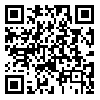Volume 11, Issue 3 (9-2017)
payavard 2017, 11(3): 342-350 |
Back to browse issues page
Download citation:
BibTeX | RIS | EndNote | Medlars | ProCite | Reference Manager | RefWorks
Send citation to:



BibTeX | RIS | EndNote | Medlars | ProCite | Reference Manager | RefWorks
Send citation to:
Imani A, Mianji F, Changizi V, Mousavie Anijdan S H, Paydar R. Assessment of Staff Exposure to Radon in Radiotherapy Centers in Tehran, 2015. payavard 2017; 11 (3) :342-350
URL: http://payavard.tums.ac.ir/article-1-6306-en.html
URL: http://payavard.tums.ac.ir/article-1-6306-en.html
Arezoo Imani1 
 , Fereidoun Mianji2
, Fereidoun Mianji2 
 , Vahid Changizi *
, Vahid Changizi * 
 3, Seyyed Hossein Mousavie Anijdan4
3, Seyyed Hossein Mousavie Anijdan4 
 , Reza Paydar5
, Reza Paydar5 


 , Fereidoun Mianji2
, Fereidoun Mianji2 
 , Vahid Changizi *
, Vahid Changizi * 
 3, Seyyed Hossein Mousavie Anijdan4
3, Seyyed Hossein Mousavie Anijdan4 
 , Reza Paydar5
, Reza Paydar5 

1- Master of Science in Radiobiology & Radiation Protection, Radiation Sciences Depertment, School of Allied Medical Sciences, Tehran University of Medical Sciences, Tehran, Iran
2- Assistant Professor, Nuclear Science and Technology Research Institute, Atomic Energey Organization of Iran,Tehran, Iran
3- Professor, Radiation Sciences Department, School of Allied Medical Sciences, Health Information Management Research Center, Tehran University of Medical Sciences, Tehran, Iran ,changizi@sina.tums.ac.ir
4- Assistant Professor, Radiation Technology Department, School of Allied Medical Sciences, Babol University of Medical Sciences, Babol, Iran
5- Assistant Professor, Radiation Sciences Department, School of Allied Medicine, Iran University of Medical Sciences, Tehran, Iran
2- Assistant Professor, Nuclear Science and Technology Research Institute, Atomic Energey Organization of Iran,Tehran, Iran
3- Professor, Radiation Sciences Department, School of Allied Medical Sciences, Health Information Management Research Center, Tehran University of Medical Sciences, Tehran, Iran ,
4- Assistant Professor, Radiation Technology Department, School of Allied Medical Sciences, Babol University of Medical Sciences, Babol, Iran
5- Assistant Professor, Radiation Sciences Department, School of Allied Medicine, Iran University of Medical Sciences, Tehran, Iran
Abstract: (3798 Views)
Background and Aim: Estimation of radon density in underground centers is very important. Considering the use of high-energy medical accelerators, radiotherapy departments are usually located in underground floors. The aim of this study was to evaluate staff exposure to radon gas in these centers in Tehran in 2015-2016.
Materials and Methods: This is a descriptive, cross-sectional survey. In radiotherapy centers of Tehran, 32 radon gas diffusion chamber detectors were installed for a period of 3 months. After collecting the detectors, radon gas concentrations were calculated. The annual effective dose of personnel was evaluated using staff’s working hours per week.
Results: The minimum and maximum concentrations recorded in this study during one year were 22.14 and 398.52 Bq/m3, respectively, with an average of 87.01 ± 80.68 Bq/m3. Also, radiotherapy personnel’s annual effective dose was 0.34 ± 0.43 mSv per year with the minimum and maximum amounts of 0.02 and 2.35 mSv per year, respectively.
Conclusion: The results indicate that radon level in radiotherapy centers and also that the annual effective dose of personnel in these centers are permissible, and no special action is needed. However, if more attention is paid to certain factors such as air-conditioning, the amount of the gas can even be brought to less than this limit.
Materials and Methods: This is a descriptive, cross-sectional survey. In radiotherapy centers of Tehran, 32 radon gas diffusion chamber detectors were installed for a period of 3 months. After collecting the detectors, radon gas concentrations were calculated. The annual effective dose of personnel was evaluated using staff’s working hours per week.
Results: The minimum and maximum concentrations recorded in this study during one year were 22.14 and 398.52 Bq/m3, respectively, with an average of 87.01 ± 80.68 Bq/m3. Also, radiotherapy personnel’s annual effective dose was 0.34 ± 0.43 mSv per year with the minimum and maximum amounts of 0.02 and 2.35 mSv per year, respectively.
Conclusion: The results indicate that radon level in radiotherapy centers and also that the annual effective dose of personnel in these centers are permissible, and no special action is needed. However, if more attention is paid to certain factors such as air-conditioning, the amount of the gas can even be brought to less than this limit.
Send email to the article author
| Rights and permissions | |
 |
This work is licensed under a Creative Commons Attribution-NonCommercial 4.0 International License. |



